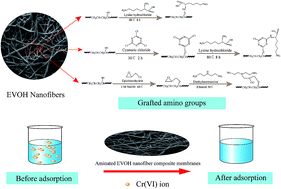Aminated EVOH nanofiber membranes for Cr(vi) adsorption from aqueous solution†
Abstract
Ethylene vinyl alcohol (EVOH) nanofiber membranes were prepared by melt-blending extrusion with cellulose acetate butyrate ester (CAB) as the matrix and a high-speed flow deposition process. Then, aminated-EVOH (L-Lys/EVOH, Cy/L-Lys/EVOH and DETA/EVOH) nanofiber membranes were prepared for hexavalent chromium [Cr(VI)] removal by facile chemical modification on the surface of EVOH nanofiber membranes. Scanning electron microscopy (SEM), Fourier transform-infrared (FT-IR) spectroscopy and X-ray photoelectron spectroscopy (XPS) were carried out to test the morphology and structure of aminated-EVOH nanofiber membranes. Adsorption experiments suggested that amination was beneficial to adsorption, and the optimal pH for prepared membranes to Cr removal was 2.0. Adsorption kinetics analysis revealed that the adsorption process was successfully fitted with a Pseudo-second-order model. The Freundlich isothermal model well described the adsorption isotherm data. A thermodynamic study suggested that the adsorption process was endothermic and spontaneous. Aminated-EVOH nanofiber membranes exhibited excellent reusability for Cr removal. The Cr adsorption efficiency of DETA/EVOH nanofiber membranes retained up to 98.73% of the initial adsorption after 6 successive adsorption–desorption cycles.



 Please wait while we load your content...
Please wait while we load your content...